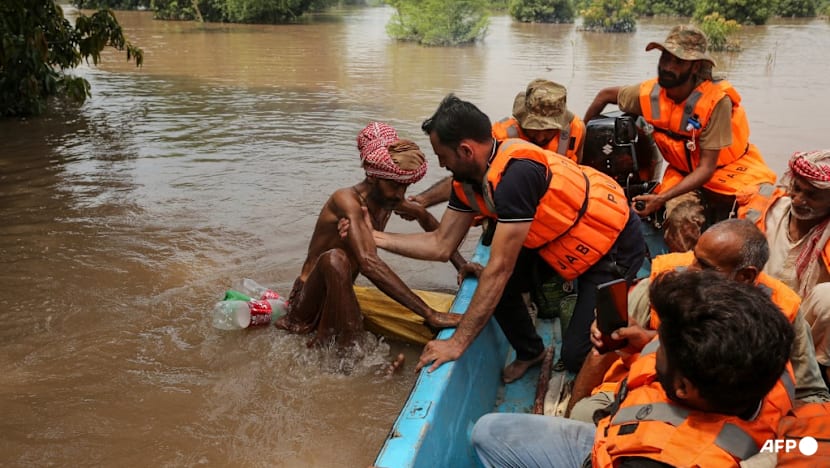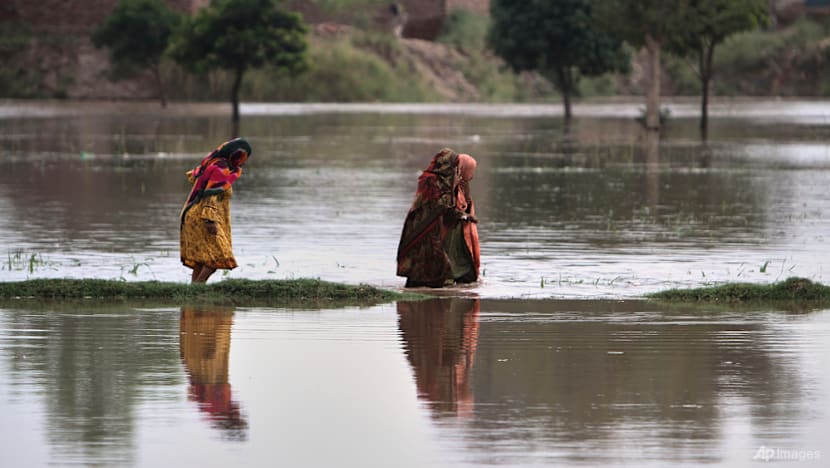Commentary: Pakistan's secret weapon can help it rebuild after floods
Pakistan has no shortage of grand plans to fix its climate vulnerability, but its greatest hope is now in such grassroots change, says David Fickling for Bloomberg Opinion.

A rescuer pulls a man on board a boat after the flood in the Chenab river, in Muzaffargarh in Punjab province on Sep 6, 2025. (Photo: AFP/Shahid Saeed Mirza)
SYDNEY: What do you do when you find yourself abandoned in your hour of greatest need?
That’s the question many in Pakistan will be asking, as the second flood disaster in three years looms. Monsoon rainfall in Punjab province has already affected two million people and killed at least 880. About 60 per cent of Punjab’s rice crop and 30 per cent of its sugarcane has been lost.
Worse may be yet to come. The rainy season won’t end for another month, and the waters are now crossing into Sindh, the province worst-hit by the 2022 floods that submerged a third of the country, killed more than 1,700 people, caused US$40 billion of damage, and cut economic growth by 2.2 per cent.
Pakistan’s roughly 250 million people have barely begun to recover from that catastrophe. Of the US$30 billion sought to rebuild the country after 2022, only US$11 billion was pledged by development banks and other donors, and just US$4.5 billion has been spent on flood recovery by this June.
That’s less than the roughly US$4.6 billion of “aid” in the donor package dedicated by oil exporters to allow Pakistan to pay for its crude on credit - hardly the best way of responding to a disaster made more likely by climate change. Development banks can’t accept all the blame, though: There simply weren’t enough investable projects looking for funds, according to Finance Minister Muhammad Aurangzeb.
WHAT'S THE FIX?
How is one of the world’s poorest countries going to fix this as the blows from global warming keep coming thicker and faster? Believe it or not, there’s a hopeful lesson in one of the darkest episodes of Pakistan’s own history.
In 1970, modern Bangladesh was a province of Pakistan, and found itself in a similar place. The Bhola Cyclone that year was the deadliest on record, killing an estimated 300,000 people as its storm surge inundated the low-lying country. Its victims found themselves abandoned by those they turned to for help: In this case, the West Pakistani elite, who made only fitful attempts at disaster relief, then blocked Bengali politicians from power after an election, and finally unleashed ethnic cleansing to suppress the growing nationalist movement.
Bangladesh’s long road from that war-torn moment to its present status, as an independent country about 50 per cent richer than Pakistan itself, is a testament to what change from below can accomplish. Despite its own deep vulnerability to natural disasters, the country has suffered fewer flood deaths in the past 25 years than Pakistan has experienced since 2020.
That’s largely been achieved without the sort of large-scale infrastructure that the likes of China and Japan have used to bulletproof themselves against catastrophes, and that Pakistan has neither the funding nor the project pipeline to build.
What’s been the secret? A crucial factor has been putting more power in the hands of women. Across South Asia, women are disproportionately at risk during natural disasters, in part because of fears of dishonour, violence and looting if they leave the family home to evacuate to shelters or relief camps. During 1991’s Cyclone Gorky in the Bay of Bengal, women accounted for about 93 per cent of the 140,000 killed.
Fixing such cultural issues can be hard, but Bangladesh has had success recruiting more women as disaster volunteers and early-warning coordinators. As those reforms have spread, death tolls in more recent cyclones hitting the country have been far lower, and more evenly balanced between genders. Pakistan has been learning a similar lesson: About 37 per cent of housing grants under a World Bank programme to rebuild from the 2022 floods have gone to women.

PULLING AHEAD
Empowering women is also going to be crucial to the development that Pakistan will need if it wants to free itself of dependence on donor nations - an important consideration, considering the way the aid budgets of the US and UK, two of the biggest donors, have been eviscerated this year.
Bangladesh’s economic miracle has been built by the millions of women who have flocked to its garment industry, turning it into the world’s largest apparel exporter after China. Some 44 per cent of women now have jobs, a share that exceeds Italy. (In Pakistan, by contrast, only 32 per cent of women even have access to a mobile phone.) That’s spurred urbanisation and investment, both of which have now overtaken rates seen in Pakistan. With each passing year, a less poverty-stricken Bangladesh gets better at protecting itself against the damage from climate change.
Pakistan has no shortage of grand plans to fix its climate vulnerability, but its greatest hope is now in such grassroots change - as demonstrated by its photovoltaics boom, which is turning it into one of the most rapid adopters of solar energy on the planet. With labour costs now lower than those of Bangladesh, whose minimum wage is far below a living income, it might even have the opportunity to copy the boom of its former province.
Floods have always been devastating. After the waters recede, however, they can nurture a new era of growth.













